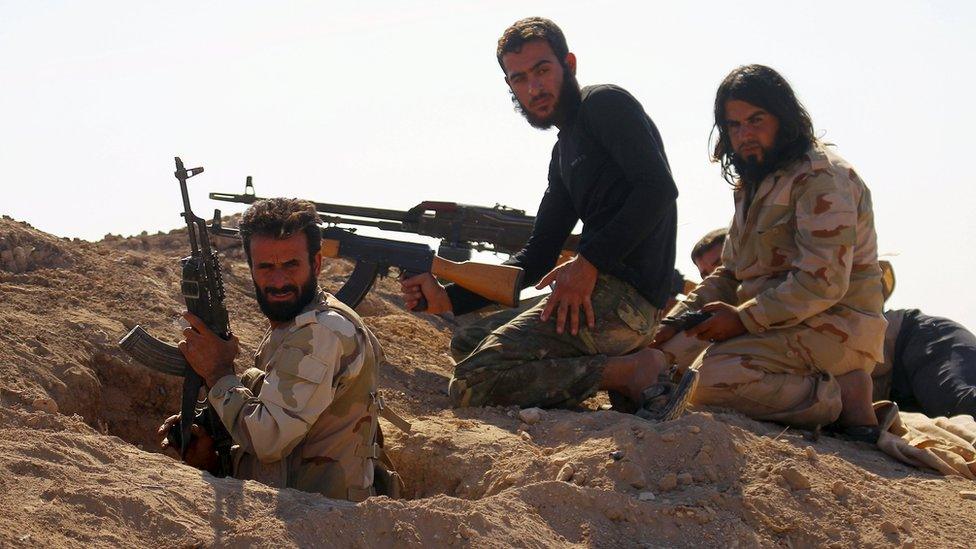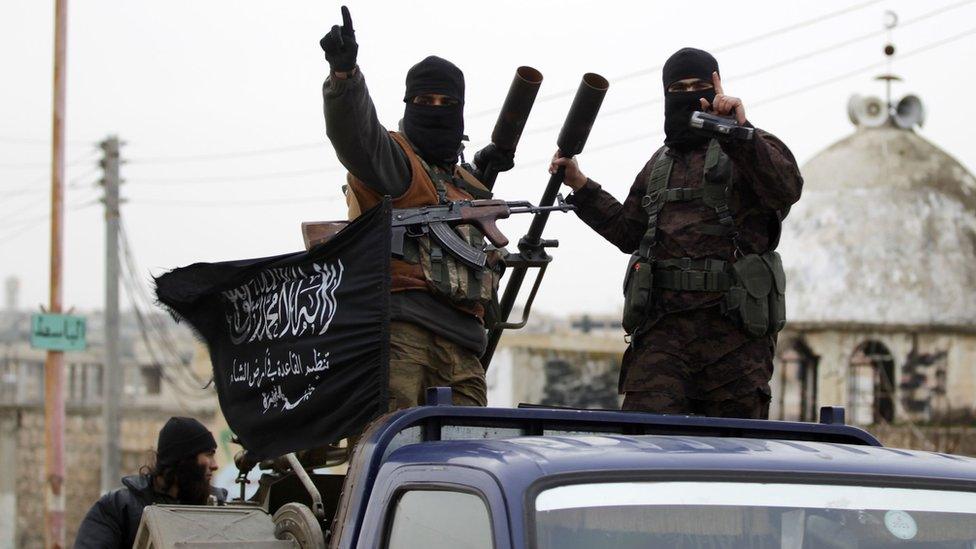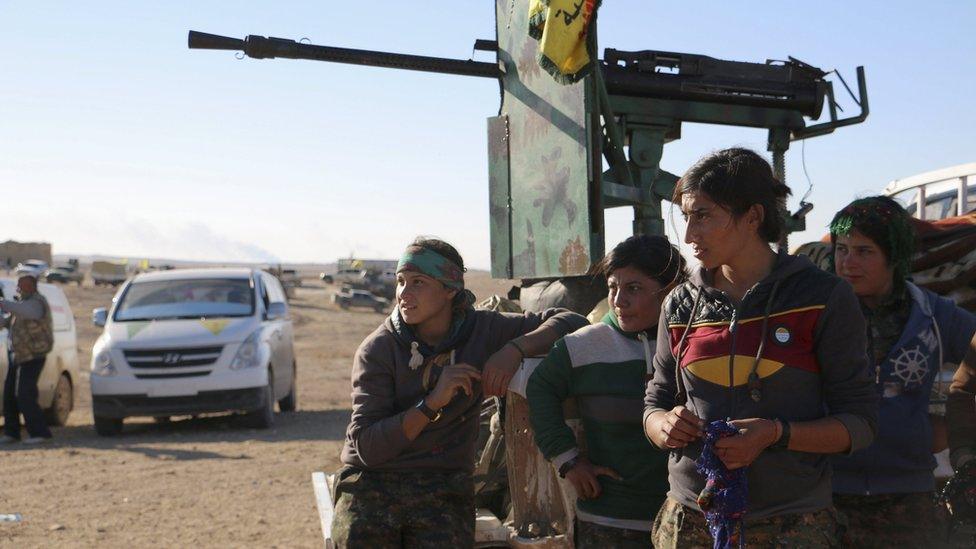Are there 70,000 Syrian 'moderates' ready to back UK?
- Published

David Cameron did not say for which groups the 70,000 rebels were fighting
In advocating a case for extending UK air strikes into Syria, Prime Minister David Cameron outlined a strategy of targeting so-called Islamic State (IS), paralleled with a diplomatic track in which the main opposition groupings sat down with the Syrian regime and worked out a transition of power.
As part of making the case for a robust diplomatic process, the prime minister noted that as many as 70,000 fighters who did not belong to extremist groups were still committed to fighting President Bashar al-Assad.
The figure has raised eyebrows: there was no clarity offered as to who these fighters are, where they are fighting, and what sort of relationships these moderate groups have to al-Qaeda, and indeed IS.
Many politicians and commentators have outright dismissed the figure as fantastical, feeding into the Russian propagandists' line that there are no "moderate" rebels left in Syria.
Moderates v hardliners
In the past week, a number of analysts have taken up the challenge to identify these rebels.

What does the British government say?
Officials say the source for the 70,000 figure is the UK's Joint Intelligence Committee (JIC), drawing on assessments by the Foreign and Commonwealth Office, UK intelligence agencies and open sources.
The figure, the officials add, refers to Syrian rebels who fulfil two basic criteria:
They renounce terrorism, ie they are not members of the jihadist groups Islamic State or al-Qaeda
They are "committed to a pluralistic Syria", ie one in which minorities like Christians and Alawite Muslims would be equal citizens

Charles Lister of the Brookings Institute puts the number of fighters in strategically influential groups at around 65,000, external - with 10,000 fighters in smaller groups.
They are spread over six identifiable fronts, stretching along a fairly narrow strip of territory from the northern city of Aleppo, down through the capital Damascus and into the southern borderlands with Jordan.
But while it may be possible to identify 65,000-75,000 personnel in brigades that fight both Assad and IS, the problem is that these groups of fighters, particularly in the north of the country, are not powerful enough to take on al-Qaeda or IS by themselves, or in many cases break their current alliances/ceasefires with them.

For example, Jaysh al-Fatah - a coalition of seven different groups operating around the northern cities of Aleppo, Idlib and Hama - is comprised of Salafist jihadists from the al-Qaeda-affiliated al-Nusra Front, and the equally unpalatable Ahrar al-Sham and Jund al-Aqsa.
Yet two other groupings in the alliance, Ajnad al-Sham and Faylaq al-Sham, display little such sentiments.
The problem is that numerically within Jaysh al-Fatah the more moderate groups do not stand a chance against the hardliners.
Piecemeal opposition
In eastern Damascus and the southern part of the country, the picture is clearer.
Militias with Jordanian and Saudi backing have fared well against Mr Assad's forces, and have been ruthless whenever they have come into contact with IS.

So-called moderate rebels have struggled to counter al-Qaeda's affiliate, al-Nusra Front
In July, Jaysh al-Islam released a video of its fighters shooting dead rivals from IS in a style that mimicked those produced by the jihadist group to announce the killing of regime soldiers and Western hostages.
Although hardly a palatable group in and of itself, Jaysh al-Islam does at least represent Syrians that live in that area, and is explicitly not jihadist.
But it is important to note that these rebels do not form a cohesive military force, able to simultaneously launch co-ordinated attacks in the manner of a standing army.
Rather, they form the backbone of piecemeal opposition, looking to establish social and political control in various different guises, and co-ordinating across a number of fronts in which they vary dramatically in terms of operational fighting strength.
Ignoring the Kurds
Regardless of the lack of clarity, the 70,000 figure does not include the Kurds.
Their Popular Protection Units (YPG) form part of a larger umbrella movement known as the Syrian Democratic Forces (SDF), which is engaged in battle with IS across a 900km (560-mile) frontline in areas where Kurds are largely the majority ethnic population.
The SDF generally operates in a tense ceasefire with the Assad regime and has even been accused of being in open alliance with it, and as a result the British government does not include the YPG or the SDF - which may have as many as 40-50,000 troops - in its estimate.

The British government's figures do not include Kurdish fighters from the YPG
But let's be honest - Western airpower and reconnaissance have been aiding the Kurdish forces for more than a year, and they are part of the West's anti-IS strategy in Syria, whether they fight Assad or not.
It is strange to think that the forces the West backs most keenly are ignored when a strategy for bombing in Syria and bringing it to a political solution is outlined.
So, counting the number of "allies" that the West considers vital to its dual strategy of defeating IS and pushing Mr Assad to the negotiating table makes the magical 70,000 number actually more like 100-120,000.
It should also refer to areas of the country already under relatively stable control, rather than the scattered assortment of opposition militias that operate in the west and south.
Lack of clarity was always going to be a problem in Syria, but the government has oversold the strength of potential allies, whilst simultaneously underselling the strength of others.
Such is Syria, where one man's ally is another's mortal enemy, leading to a strategy in which the best solution is to back the groups we dislike the least.
Michael Stephens is the Research Fellow for Middle East Studies and Head of Rusi Qatar. Follow him on Twitter @MStephensGulf, external